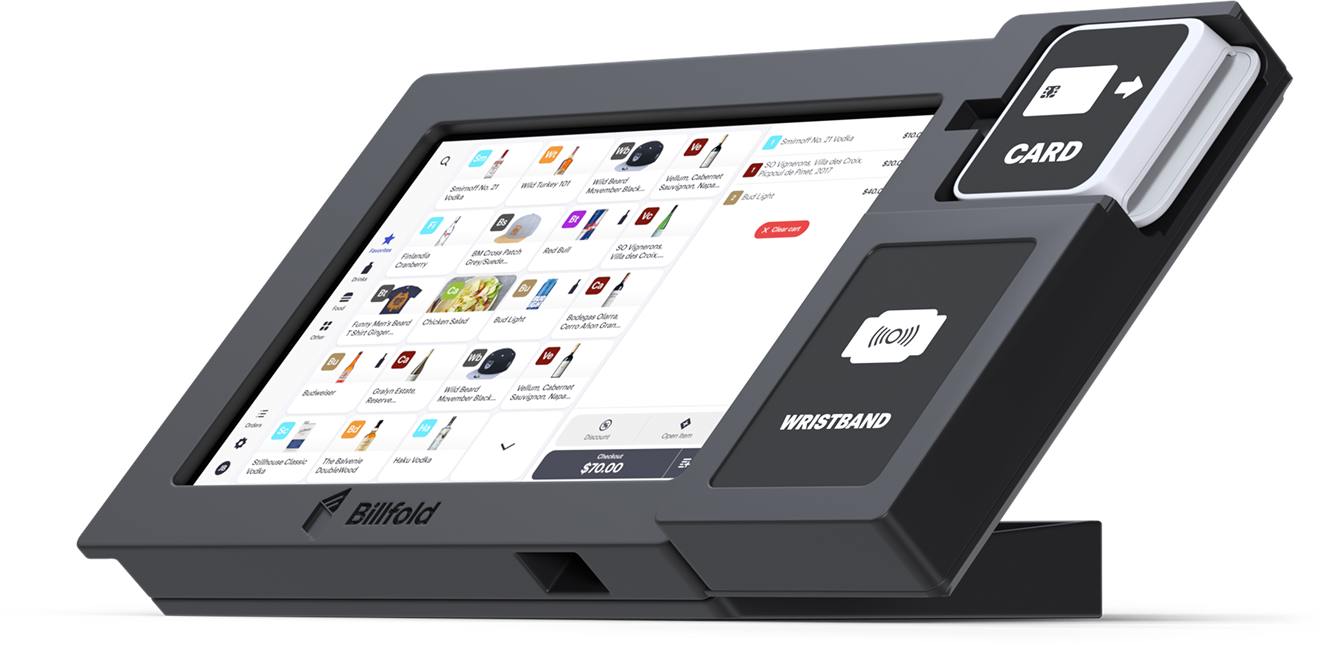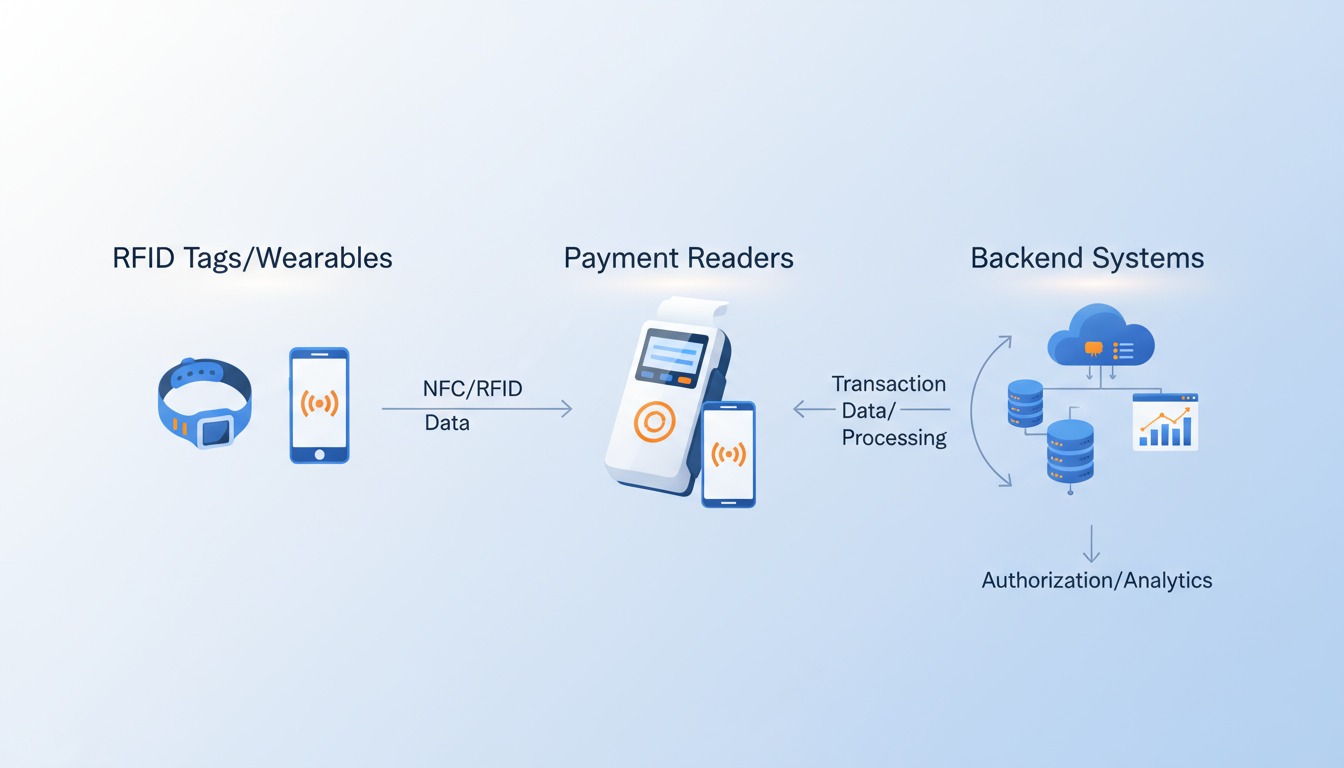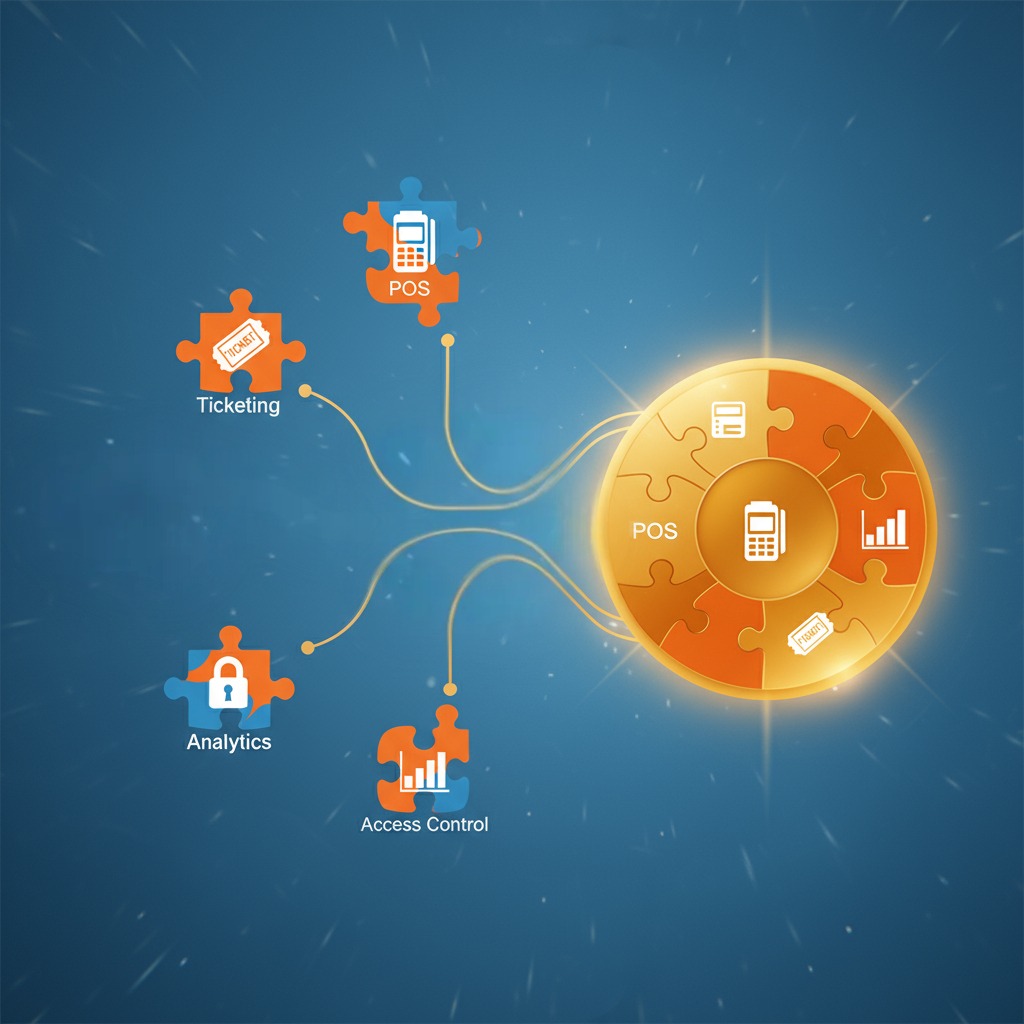Integrating Contactless POS with Event Technology: What to Know

Key Takeaways
Modern contactless POS systems eliminate operational silos by connecting payment processing, ticketing, and analytics into unified platforms that drive both efficiency and revenue.
- Integration benefits: Unified data flows reduce manual administrative processes while enabling comprehensive customer insights across all touchpoints
- Technical requirements: RFID-enabled hardware, middleware systems, and API-compatible software create seamless connectivity between existing platforms
- Security standards: Bank-level encryption and PCI compliance protect transactions while maintaining contactless convenience for customers
- Implementation impact: Events report significantly faster transaction processing and measurable operational cost reductions
Smart venues choose integrated payment solutions that connect natively with existing event technology rather than adding more disconnected tools.
The modern event landscape demands more than standalone payment terminals. Today's successful venues require contactless POS systems that integrate seamlessly with ticketing platforms, analytics dashboards, and customer engagement tools. According to Fortune Business Insights, the global RFID market size was valued at USD 15.49 billion in 2024 and is projected to grow from USD 17.12 billion in 2025 to USD 37.71 billion by 2032, exhibiting a CAGR of 11.9% during the forecast period.
Yet most venues still struggle with fragmented systems where ticketing platforms operate independently from POS systems, analytics require manual data exports, and customer insights remain scattered across multiple platforms. This fragmentation costs venues both operational efficiency and revenue opportunities.
Understanding How Contactless POS Technology Works
Contactless POS represents a fundamental shift from traditional payment processing toward integrated transaction ecosystems. These systems utilize multiple payment technologies working in harmony: RFID technology uses radio waves to identify and locate objects through reader-tag communication, while NFC enables secure, short-range data exchange between devices operating at 13.56 MHz frequency.
The power lies in versatility. Modern contactless POS systems accept RFID wristbands, NFC mobile payments, traditional bank cards, and QR codes within a single terminal. This multi-format capability eliminates customer friction while providing venues with comprehensive transaction data.
RFID POS systems specifically excel in high-volume environments because they process transactions without network dependencies. Unlike contactless cards that require network connectivity for each transaction, RFID payments process instantly without external dependencies, proving crucial for outdoor events, remote locations, or venues with unreliable internet connectivity.
Integration capabilities separate professional-grade contactless POS systems from basic payment terminals. Advanced platforms include APIs that connect with existing venue management software, middleware that translates between different system protocols, and real-time data synchronization that keeps all platforms current.

Key Integration Challenges in Event Technology
The biggest obstacle isn't technology limitations but rather the complexity of connecting systems that weren't designed to work together. Every ticketing platform speaks one language, POS systems another, and analytics dashboards require manual data exports that are outdated before you finish the report.
Data silos represent the most significant challenge. Traditional event operations often involve separate vendors for ticketing, payments, access control, and analytics. Each system maintains its own database, creating information gaps that limit operational visibility and customer understanding.
Infrastructure compatibility poses another hurdle. Legacy venues may have existing POS hardware, network configurations, and software systems that don't easily accommodate modern contactless technology. With digital payment adoption increasing, reporting becomes more challenging since establishments have many payment sources with money hitting different accounts.
Staff training requirements shouldn't be underestimated. Integrated systems change workflows, require new troubleshooting skills, and often alter fundamental operational procedures. Successful implementations include comprehensive training programs and ongoing support structures.
Network reliability becomes critical when multiple systems depend on constant connectivity. Events in remote locations or outdoor venues must plan for connectivity challenges that could affect system integration performance.

Essential RFID POS Systems Features for Event Integration
Modern event venues require specific capabilities to maximize their contactless POS investment. These eight features represent the difference between basic payment processing and comprehensive event technology integration:
Unified Transaction Processing enables single terminals to handle multiple payment methods seamlessly. RFID wristband technology eliminates customer confusion by accepting their preferred payment method without requiring different terminals or procedures.
Real-Time Analytics Integration connects transaction data directly with venue management platforms. This connectivity enables instant inventory tracking, dynamic pricing adjustments, and crowd flow optimization based on purchase patterns.
Access Control Synchronization links payment capabilities with entry management systems. Customers can use the same wearable device for venue entry, age verification, VIP area access, and transaction processing throughout their visit.
Multi-Vendor Management supports complex events with multiple food vendors, merchandise booths, and service providers. Centralized reporting provides organizers with comprehensive financial visibility while maintaining individual vendor accountability.
Offline Operation Capability ensures transaction processing continues during network disruptions. RFID systems operate completely offline by storing transaction data locally and synchronizing with central servers when connectivity resumes.
Customer Data Platform Integration connects transaction information with marketing automation, loyalty programs, and customer relationship management tools. This integration enables personalized promotions, targeted communications, and enhanced customer lifetime value.
Inventory Management Synchronization automatically adjusts stock levels based on real-time sales data. This capability prevents stockouts, enables dynamic menu management, and optimizes vendor restocking schedules.
Financial Reporting Automation consolidates multi-vendor, multi-location transaction data into unified reports. Automated reconciliation reduces administrative overhead while improving financial accuracy and compliance.

Security and Compliance Considerations
Contactless payment integration amplifies both security opportunities and compliance requirements. Modern systems must balance transaction convenience with robust data protection protocols.
Encryption standards form the foundation of secure contactless payments. Both RFID and NFC technology offer secure, convenient solutions with proper PIN protection and secure PCI payment protocols. Advanced systems employ end-to-end encryption that protects data from the initial tap through final settlement.
PCI compliance becomes more complex when integrating multiple systems. Each integration point represents a potential vulnerability that must meet Payment Card Industry standards. Professional implementation ensures compliance across all connected platforms while maintaining audit trails for regulatory requirements.
Data privacy considerations multiply when customer information flows between integrated systems. Data privacy protections ensure attendee information remains secure throughout the event lifecycle through encrypted data storage, limited access controls, and clear data retention policies.
Fraud prevention capabilities must operate across integrated platforms. Modern contactless POS systems include real-time fraud detection, transaction velocity monitoring, and suspicious activity alerts that protect both venues and customers.
Access controls become critical when multiple systems share sensitive customer and financial data. Role-based permissions ensure staff members access only the information necessary for their responsibilities while maintaining comprehensive audit logs.
Modern event technology continues evolving toward more personalized and interactive attendee experiences that require careful security consideration when integrating with payment systems.
Implementation Best Practices for Event Technology Integration
Successful contactless POS integration requires strategic planning that addresses technical, operational, and human factors. The most critical decisions happen before any hardware installation begins.
Infrastructure assessment should precede vendor selection. Venues must evaluate network capacity, power requirements, and physical space constraints that affect system placement and performance. Smart venue operators choose hardware that supports industry-standard protocols rather than proprietary formats that limit future flexibility.
Pilot program deployment reduces implementation risks by testing integration capabilities before full-scale rollout. Start with a single vendor location or event area to identify potential issues and refine operational procedures before expanding system-wide.
Staff training programs must address both technical operation and customer service aspects. Modern payment systems require different troubleshooting skills compared to traditional terminals, and customer questions about new payment methods require knowledgeable responses.
Vendor coordination becomes essential when integrating multiple event technology platforms. Establish clear communication protocols, define integration responsibilities, and create testing schedules that ensure all systems work together before go-live dates.
Performance monitoring tools should track both system uptime and integration effectiveness. Monitor transaction processing speeds, data synchronization delays, and error rates across all connected platforms to identify optimization opportunities.
Backup procedures must account for integration dependencies. When systems are interconnected, single point failures can affect multiple operational areas. Establish manual override procedures and backup data collection methods for critical system failures.
ROI and Performance Metrics for Integrated Systems
Investment in contactless POS integration delivers measurable returns across multiple operational areas. Understanding these metrics helps venues optimize their technology investments and justify expansion decisions.
Revenue impact provides the most compelling ROI justification. Research from Insider Intelligence projects that per-user contactless spending will reach $7,827 in 2026, about double the spend in 2022 ($4,177), and more than triple the 2019 figure ($2,101).
Additionally, industry analysis shows that retailers understand the benefits of contactless payments, which include reduced transaction time, increased revenue, and improved operational efficiency. This dramatic improvement reflects both increased transaction frequency and higher spending amounts when customers can make purchases effortlessly with contactless payment devices.
Operational efficiency improvements reduce labor costs while improving customer experience. Traditional point-of-sale systems create bottlenecks during peak demand periods, while RFID POS systems process payments in under two seconds, enabling organizations to serve more customers during critical revenue periods.
Customer satisfaction metrics improve across multiple dimensions. Reduced wait times, eliminated cash handling, and simplified payment processes contribute to higher Net Promoter Scores and repeat visit rates. Payment system integration creates seamless customer experiences that differentiate venues from competitors.
Data value represents a significant but often overlooked ROI component. Integrated systems provide customer behavior insights, spending pattern analysis, and operational optimization opportunities that drive long-term revenue improvements beyond immediate transaction processing.
Administrative savings accumulate through automated reporting, reduced cash handling, and streamlined reconciliation processes. Events implementing integrated RFID payment systems report operational cost reductions through unified data flows between payment processing, inventory management, and customer analytics systems that reduce manual processes by up to 60%.
Future of Event Technology Integration
The trajectory toward comprehensive event technology integration accelerates as customer expectations evolve and operational pressures increase. Forward-thinking venues position themselves for emerging trends while maximizing current technology investments.
Artificial intelligence integration will enhance existing contactless POS capabilities through predictive analytics, personalized recommendations, and automated operational adjustments. AI-powered solutions are making significant impact, with 35% of industry respondents seeking generative AI capabilities that enhance and streamline processes from front-of-house to back-of-house operations.
Biometric authentication represents the next evolution in contactless payments. Advanced facial recognition technology is beginning to replace traditional check-ins, providing faster, seamless event entry and enhanced security through contactless solutions that prioritize health and safety.
Blockchain technology will address security and authenticity challenges in event ticketing and payments. Web3 technologies are emerging to transform event ticketing with secure, verifiable ownership systems that eliminate scalping and fraud.
IoT sensor integration will connect contactless POS data with environmental monitoring, crowd management, and facility optimization systems. This connectivity creates comprehensive operational intelligence that optimizes both customer experience and venue efficiency.
The venues that embrace comprehensive integration strategies today position themselves for sustained competitive advantage in an increasingly digital marketplace. Success requires choosing technology partners who understand both technical complexity and business implications of integrated event systems.
Frequently Asked Questions
How long does contactless POS integration typically take? Implementation timelines vary based on venue complexity and existing infrastructure. Simple single-location deployments often complete within 2-3 weeks, while multi-vendor festival integrations may require 6-8 weeks for full deployment including staff training and system testing.
Can contactless POS systems work with existing ticketing platforms? Yes, modern contactless POS systems include APIs and middleware solutions that integrate with major ticketing platforms. The key is choosing systems that support industry-standard protocols rather than proprietary formats that limit connectivity options.
What happens if network connectivity fails during an event? Professional RFID POS systems operate completely offline by storing transaction data locally and synchronizing with central servers when connectivity resumes. This capability ensures continuous operation even in remote locations or during network disruptions.
How secure are integrated contactless payment systems? Integrated systems employ bank-level security including advanced encryption, tokenization, and fraud detection. All components must maintain PCI compliance standards, and data transmission between integrated platforms uses secure protocols that protect customer information.
What ROI can venues expect from contactless POS integration? Industry data shows venues typically achieve positive ROI within 6-12 months through increased revenue and operational savings. Events report measurable improvements in transaction processing speed and significant reductions in administrative overhead.
Modernize Your Event Payment Systems
Contactless POS integration with event technology represents more than a payment upgrade—it creates the foundation for data-driven venue operations that deliver superior customer experiences while optimizing business performance. The evidence supports immediate action: with contactless payment adoption accelerating and customer expectations evolving rapidly, venues that delay integration risk falling behind competitors who leverage these technologies effectively.
The path forward requires strategic thinking about integration rather than isolated technology purchases. Choose systems that connect naturally with existing platforms, provide comprehensive data insights, and scale with operational growth. Event POS solutions demonstrate how unified platforms eliminate operational bottlenecks while unlocking new revenue streams.
Ready to transform your event technology infrastructure? Contact our team to discover how integrated contactless POS solutions can optimize your venue operations and enhance customer experiences.

